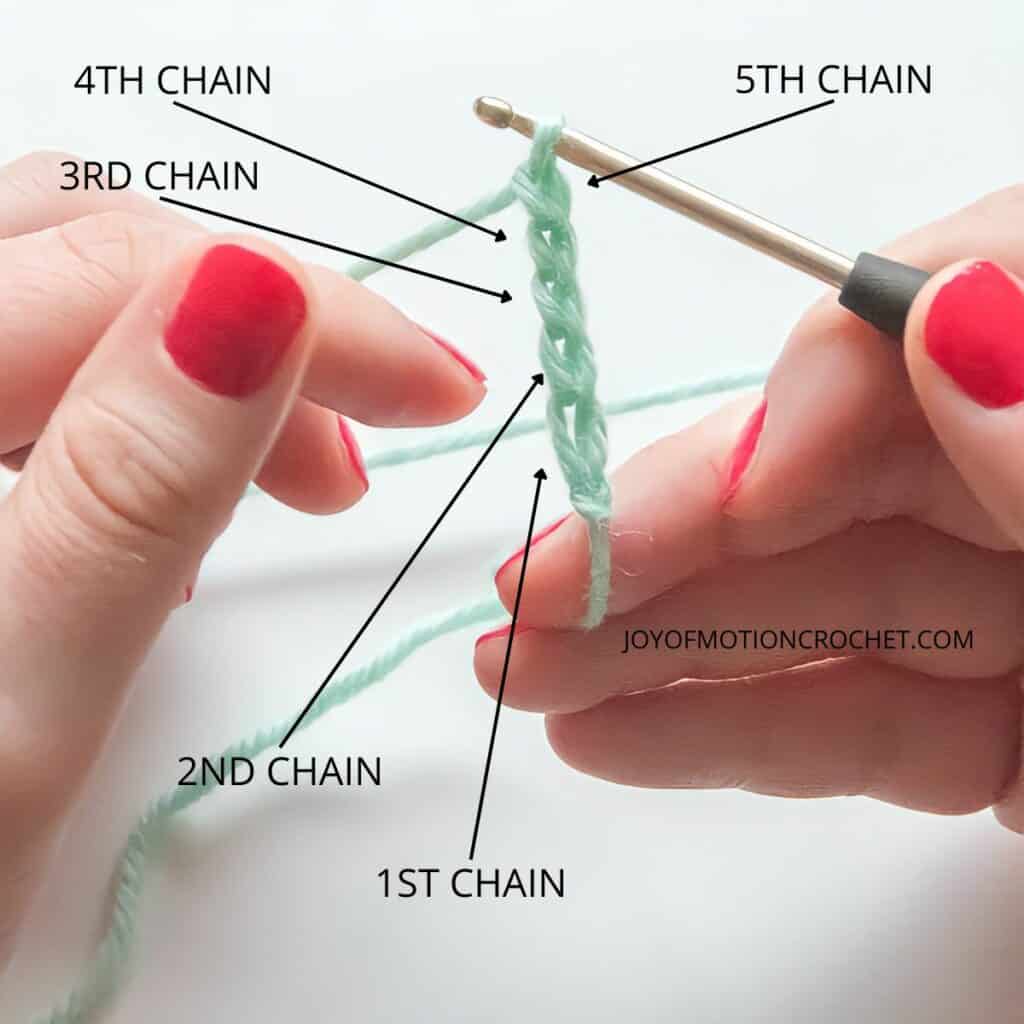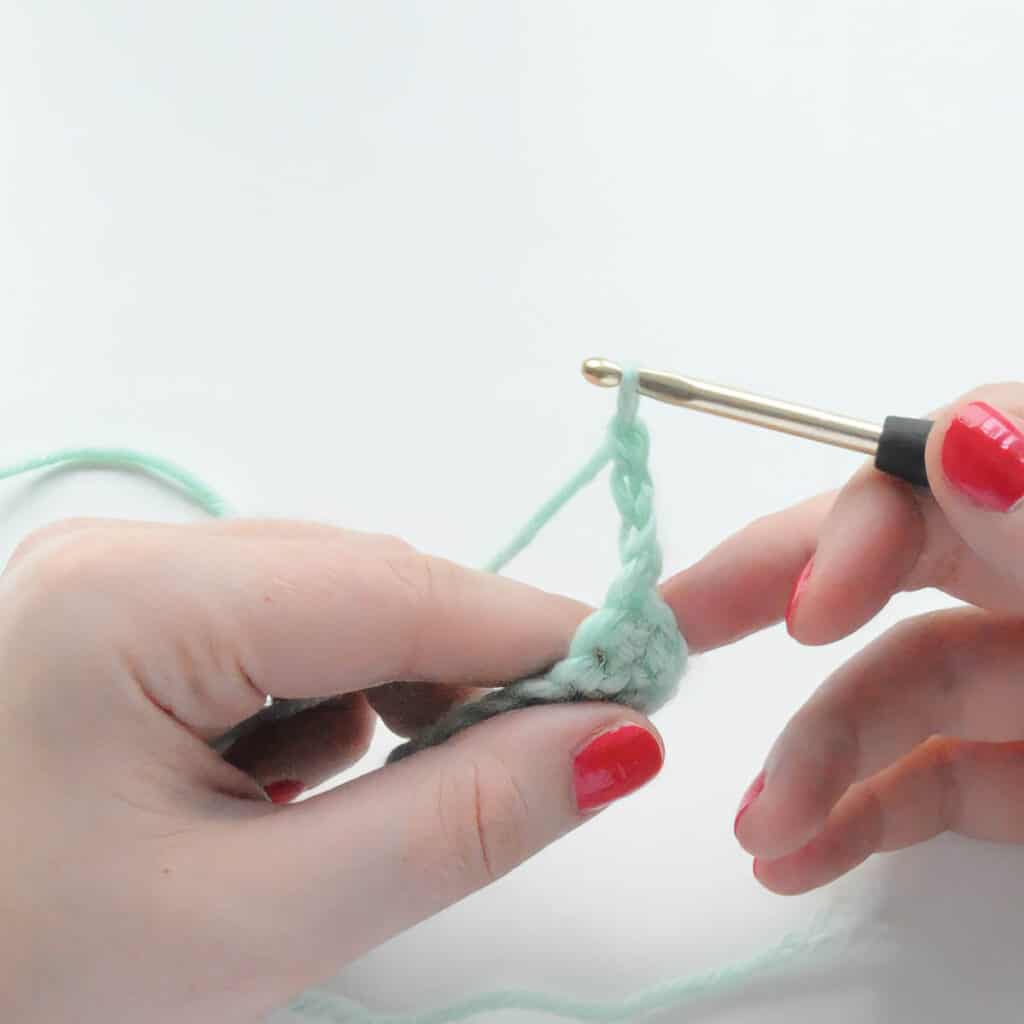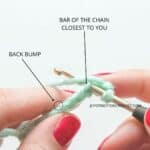The chain stitch crochet is one of the essential stitches that all beginner crocheters should learn in the first few hours of starting out. Once you’ve mastered the most basic crochet stitches, you’ll be able to move on to more complicated crochet stitches and stitch patterns.
With this crochet chain stitch tutorial, learning how to start a chain crochet project, you’ll be well on your way to learning how to crochet.
Chains are often used to start a crochet project, often called the foundation chains. When you advance you may want to learn foundation stitches such as the foundation single crochet.
The crochet chains are also used when starting rows, and are then refereed to as turning chains.
So if you’re new to crochet, start with the chain stitch crochet and follow our easy step-by-step guide below to learn how to do it.

What is a Crochet Chain Stitch?
A crochet chain stitch is a basic stitch that is often used to create a foundation row or to start a new row.
The word chain comes from the fact that it loos like a metal chain when crocheted, a series of rings connected together.
To start a crochet chain stitch, you will need to make a slip knot.
Then the steps of the crochet a chain stitch is to yarn over and pull through the loop on your hook.
Continue yarn over and pull through the loop on your hook until you have chained the desired number of crochet stitches.
Crochet Supplies You Need to Crochet a Chain
Any crochet hook size and yarn.
For crocheting chains you can use any type of yarn from acrylic yarn, wool yarn to cotton yarn.
If it is you first project, I suggest trying size:
- 3 light yarn with a 4.5 mm, 5 mm or 5.5 mm crochet hook
- 4 medium yarn with a 5.5 mm, 6 mm or 6.5 mm crochet hook
- 5 bulky yarn with a 6.5 mm, 7 mm, 8 mm or 9 mm crochet hook
In the photos the yarn used was 4 medium worsted weight yarn.
The exact sizes doesn’t matter, but the experience for a beginner improves if you have a crochet hook and yarn that match fairly well.
If you do start with a yarn that’s a lot thinner, it may become more challenging, the same goes with a crochet hook and yarn that’s a lot thicker.
If you have just one hook and yarn, use what you have!
How to Chain Stitch Crochet
A quick written description of how to make a crochet chain.
- Starting a crochet chain with a slip knot
- Yarn over
- Pull yarn through the loop
- Repeat step 1 and 2 to make more crochet chains
Chain Stitch Abbreviation
The most common crochet abbreviation is ch in both US crochet terms and UK crochet terms.
This is used for both multiple chains and one chain.
You will mostly also see the abbreviation list written like this: ch = chain(s).
Save to Pinterest!

Chain Stitch Chart Symbol
The chain stitch crochet chart symbol is simple and looks like a “0” (zero).
It will be turned in the direction it will lay in your finished crochet work.
Photo showing the ch crochet stitch chart symbol.

Making Chain Stitch Crochet – Step By Step Photo Tutorial
1. Make a Slip Knot

Make a slipknot loop and place it on your crochet hook.
How To Start A Crochet Chain:
- Hold the yarn in your hands
- Cross the short yarn tail in front of the long to create a loop.
- Cross the long yarn tail over the loop.
- Pull the long yarn tail through the first loop you made.
- With the crochet hook in your right hand, place the slipknot onto your crochet hook.
- Pull the long yarn tail to tighten the slip knot.
Find a detailed guide on how to start crochet chain with a slip knot and how to place it onto your crochet hook on the Full How to Make a Crochet Slip Knot Tutorial.
2. Yarn Over

The next step is called yarn over. Hold the long yarn tail in your left hand and place it over your crochet hook. Notice how you should hold the short yarn tail between your middle finger and ring finger to stabilize it.
Always yarn over from back to front.
3. Pull Yarn Through The Loop

The yarn you just “yarn over” will stay completely in place & the loop will make it’s way over the yarn & the hook. You have now made the first chain stitch.
4. Repeat Step 2 and 3

Repeat steps 2 and 3 once to crochet the second chain. Then repeat the steps again to crochet more chains and obtained the desired number of stitches.
Step By Step Video Tutorial Making A Chain Stitch
Counting Your Chain Stitches
To continue on to crochet single crochet stitches (sc) or other basic crochet stitches, you will need to know how to count your chains.
On the photo below you will see 5 chains crocheted and the arrow pointing to the numbered chain stitch.
Each time you repeat yarn over and pull the loop through, you will create a loop called the chain stitch.

Chain Stitches in a Pattern
In crochet patterns you may come across chain stitches at the beginning of the pattern, often referred to as foundation chain stitches.
You will also come across chains at the beginning of rows called foundation chain stitches.
Then you may also come across them as a part of a stitch pattern, where one chain or multiple chains often creates chain-spaces.
If not abbreviated, the pattern will say “chain + the number of chains”, like “chain 2”. If the pattern uses abbreviations it will cay “ch + the number of chains”, like “ch 2”.
Crochet Foundation Chain Stitches
The foundation chain crochet stitches are the first chains you crochet to create a crochet project.
In most cases you crochet into chains made on the foundation row on the first row or round of the crochet project. Like working single crochets into chains.
Without the foundation chain stitches, you wouldn’t have anything to crochet into to create your crochet project and because of this the chains are essential stitches when crocheting.
These crochet stitches are often also called crochet start chain or crochet starting chain.

How are the foundation chain stitches used?
- For crochet project worked in rows, these chain stitches will make up the width of your crochet project.
- When crocheting in rounds, these chain stitches will make up the circumference of your crochet project.
- If you are crocheting a flat piece worked from the center outwards, like granny squares, these stitches will in most cases form a ring with a slip stitch. You will then work into the ring on the first round of this crochet project. In some cases you make a magic circle instead of chains on these types of projects.
Foundation chain stitches as you become more experienced
If you become a more experienced crocheter, you may swap the foundation chain stitches for other foundation stitches, such as the foundation single crochet.
However, the foundation chains are used by beginners and beyond.
Crochet the Turning Chain Stitch
When you are working in both rows and rounds, you will come across the term crochet turning chain.
These are chains you crochet to start the row, that may count as the first stitch of the row. If it counts as a stitch or not will be specified in the pattern.
The number of turning crochet chains you crochet depends on the height stitch you will crochet on the next row. If you have a low stitch, like a row of single crochet, you may only chain 1. For a taller stitch like the double crochet stitch you will crochet 2-3 chains to reach the correct height.

What are turning in crochet?
Turning in crochet means to flip your work to the other side to start a new row or round. In that case you will change the direction you are working in to crochet into the stitches you most recently crocheted.
In other words when you turn your work in crochet you will work with the other side of your crochet project facing you.
Do you always turn your crochet work?
If you are crocheting in rows, you will always turn you work at the end of the row to crochet back and forth.
When crocheting in rounds, you will in some cases not turn your work and in other cases not. The pattern will tell you if you are supposed to turn your work or not.
No matter if you are turning your work or not, you will start rows with chains.
What are chain spaces in crochet?
When chains are used to create gaps or openwork stitch pattern they are refereed to as chain spaces.
To create a chain space, you will crochet chains and then in most cases also skip a given number of stitches to create gaps.
Stitch patterns that include chain spaces are often called lace stitch patterns, but can also be found in the traditional granny squares.
Chain spaces are often abbreviated “ch-sp”. If specified with a number they will be abbreviated like this: “ch-2-sp”, “ch-3-sp” ect.

Commonly Asked Questions About The Chain Stitch Crochet
Is a chain stitch the same as a single crochet stitch?
No, the chain isn’t the same as a single crochet stitch. The chain are a made with the two steps: yarn over and pull yarn through the loop. The single crochet are made with 3 steps: Insert hook into stitch/space to pull up a loop, yarn over and pull yarn through the loop on the hook.
What is the difference between a chain and a stitch in crochet?
There’s a difference between a chain and a stitch in crochet. The biggest difference is the fact that a chain is a stitch. A stitch in crochet can be any type of steps starting of with working into a given space and that finish of with having just one loop on the crochet hook. Examples are a single crochet, double crochet and more complex stitches.
Where do I crochet into a chain?

When crocheting into a chain you will most commonly crochet into the bar that is closest to your.
You may also work into the back bump of the chain, which are the small bump on the backside of the crocheted chains. This will create a more pretty edge on your crochet project.
What does it mean to chain 1 crochet?
To chain 1 crochet you will yarn over and pull the yarn through the loop on your crochet hook.
Why does my chain look messy?
There are multiple reasons why your chain may look messy. If you are a beginner crocheter you may not have practice in keeping your tension even as you crochet the loops. That may cause messy looking chains. Next, if your crochet hook is thicker than suggested on your yarn label, you may also have too loose tension that often results in messy looking chains.
To avoid messy looking chains, go down in crochet hook and practice, practice, practice!
Next Steps for Learning Crochet as a Beginner
After making a slip knot crochet and learning how to make a chain in crochet, the next steps of the beginners guide to crochet is:
Beginner Crochet Patterns To Try
After learning how to crochet a chain from the beginner crochet tutorials, many start by crocheting scarfs or blankets.
However, these free patterns are great for beginners:




